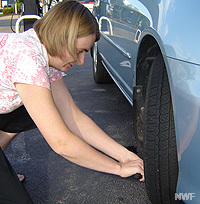Checking Tire Pressure Before Traveling in Winter Weather Makes for a Safer Trip
 |
WASHINGTON, Feb. 9, 2007 -- As severe winter weather grips the nation, the Alliance of Automobile Manufacturers wants to remind drivers to check their tire pressure, especially before driving on icy and snowy roads.
Winter's weather already makes for challenging driving, but when a car's tire pressure is under inflated, it can compromise the safety and fuel efficiency of the vehicle. Temperature change is one external factor that can have an impact on a vehicle's tire pressure. Tire pressure is measured by pounds per square inch (PSI) and for every 10-degree change in temperature -- a tire can lose about one PSI.
"Old man winter has gripped our nation and with these freezing cold temperatures, we want to urge the driving public to check their vehicle's tire pressure at least once a month, especially before driving in this cold weather," said Fred Webber, president and CEO of the Alliance of Automobile Manufacturers. "In addition, vehicles are now being equipped with Tire Pressure Monitoring Systems, and we want to educate the driving public about what these new symbols mean and why maintaining proper tire pressure is important."
In order to help travelers before they venture out this winter, the Alliance has launched a new Web site, http://www.checkmytires.com/, which is an interactive site designed to test an individual's knowledge of tire pressure and to communicate how temperature, safety and fuel efficiency impact tire pressure. Drivers can even check the weather at their destination.
"Maintaining proper tire pressure is something that many people may neglect, but it is vital for the safety and fuel efficiency of the vehicle," said National Highway Traffic Safety (NHTSA) Administrator Nicole Nason. "All of us can take simple everyday steps to enhance automobile safety this winter, and NHTSA urges everyone to remember to check their tire pressure."
Safety and fuel efficiency are two important reasons to maintain proper tire pressure. Under inflated tires can lead to accidents that involve skidding or loss of control, hydroplaning on wet or icy surfaces, and flat tires/tire blowouts. Additionally, fuel efficiency is reduced one percent for every three-PSI under proper inflation, so keeping tires properly inflated translates to a free tank of gas every year.
Individuals can log onto the Alliance's new Web site, http://www.checkmytires.com/, to learn what the new dashboard Tire Pressure Monitoring Systems (TPMS) symbol looks like in vehicles, check the weather in their hometown, and take an interactive quiz to learn about how temperature changes, safety and fuel efficiency all play a role in maintaining proper tire pressure.
By model year 2008, all new vehicles will be equipped with TPMS. About 70 percent of vehicles will come equipped with TPMS by September 2007. "The new symbols are not a replacement for regularly checking the tire pressure in your vehicles, especially as winter temperatures rapidly fluctuate," Webber added. "A driver can verify the vehicle's proper tire pressure on a label located in one of three places in the vehicle: on the driver's door frame, sill or edge."


